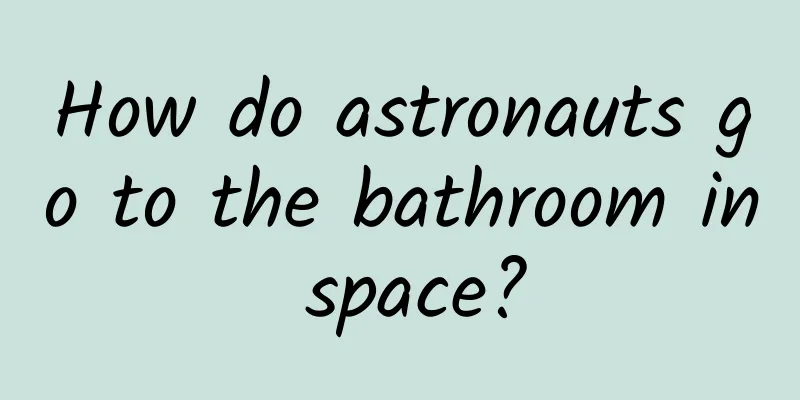How do astronauts go to the bathroom in space?

|
"I believe that this nation should commit itself to the goal of landing a man on the moon and returning him safely to the earth before the end of this decade. No space program will leave a greater impression on mankind, or be of greater significance to the long-term exploration of space, nor will any task be so difficult or expensive." These were the words of John F. Kennedy, the 35th President of the United States, in his State of the Union address to Congress on May 25, 1961. Such a declaration was bold and exciting, and of course, in the eyes of some people, it seemed stupid. At the time, Ladbrokes bet at odds of 1,000:1 that Kennedy's declaration would not come true. In 1969, American astronauts successfully walked on the surface of the moon and returned safely to Earth. Humanity has taken great strides. This article is authorized to be excerpted from "BBC Universe Primer: How to See the World" (Jiangsu Phoenix Science and Technology Press). Go to the "Fanpu" public account and click "Read the original text" at the end of the article to purchase this book. Click "Reading" and post your thoughts in the comment area. By 12:00 noon on October 17, 2021, we will select 2 comments and give away 2 books in total. Translated by Shao Xin Space Science What do astronauts do on the space station? They spend part of their time living - sleeping, cooking, eating, exercising - and most of the rest of their time working: maintaining and repairing equipment, doing physiological health tests, conducting scientific experiments, etc. Some of these scientific experiments are designed to test a theory. For example, at the end of the Apollo 15 mission, David Scott dropped a hammer and a feather from the moon at the same time. On Earth, the feather would fall slowly due to air resistance. But on the moon, which has no atmosphere, they fell together and hit the lunar surface at the same time. This shows that weight does not affect the speed of an object as long as it is not affected by air resistance when it falls. Galileo expressed this idea in 1590, and Adam also tested it by dropping tomatoes of different sizes from the Leaning Tower of Pisa. NASA has a very extensive life science research program in which astronauts study everything from the effects of weightlessness on their bodies to the growth of plants and animals in space. For plants and small animals, scientists hope to track their growth and development by observing at least two full generations to see how microgravity or zero gravity affects their growth. The experiments showed that this did not seem to affect invertebrates, so the next subjects were small mammals and fish. There are still many questions to be answered: What effect does weightlessness have on the inner ear sensors and the brain? Do small animals experience the same degree of muscle atrophy and bone loss as humans? Can plants grow normally in zero gravity? Which parts of plants are sensitive to gravity? Can enough edible plants be grown to provide food for astronauts? The Apollo-Soyuz Test Program, Skylab, and later the Space Station all forced planners to confront the problems and challenges that would be encountered in both short- and long-duration spaceflight. The first is the excess gravity caused by acceleration during launch, which has proven to be less of a problem if the astronauts' bodies are immobilized and well supported. Astronaut David Scott demonstrates the hammer and feather experiment on the moon for millions of television viewers. Archives丨Space Experiments This scientist on the International Space Station monitors plant growth in zero gravity. Some experiments have also been conducted in space to grow protein crystals. Scientists hope to better understand protein structure in an environment without the influence of gravity. Tissue culture processes may also change when cells are in a state of weightlessness. Observing the Earth from space is expected to provide useful information on global warming, desertification and other issues. weightlessness Weightlessness, or zero gravity, is also known as zero gravity. In Earth orbit, astronauts are not truly weightless, and gravity is not zero. In fact, the spacecraft is constantly falling toward the Earth, and so is the interior of the spacecraft. Because the falling acceleration is the same, there is no interaction between the astronaut and the "floor" of the spacecraft. It's like when you bounce on a trampoline, you are in a state of free fall or weightlessness the entire time you are off the trampoline. Imagine trying to pour water from one container (preferably plastic) into another while you are off the trampoline. You will find it quite difficult. This is commonly referred to as weightlessness or zero gravity, and it is what astronauts experience. In zero gravity, objects float if they are not secured. You can't walk on the "floor" normally, but have to use things like Velcro or magnetic boots. You can't put things on tables or shelves, but have to secure them. Weightlessness often causes space sickness, which, like seasickness, is caused by conflicting signals to the brain about up and down. As the semicircular canals in your ears work (quite slowly) under the influence of gravity, your eyes can tell you where you are horizontally, so you can tell which way is up and which is down. In zero gravity, your ears have never adapted, and even your eyes often can't tell where you are horizontally, and the physiological reaction is nausea. Many astronauts have experienced severe space sickness, but fortunately the symptoms seem to pass in two or three days. In addition, long-term lack of exercise can cause muscle atrophy, so the space station is equipped with exercise bikes, vibrating fitness machines, etc. However, these machines are modified to allow astronauts to be secured to them. After a period of time in zero gravity, the amount of blood in the human body also decreases. In space, astronauts don't feel too much discomfort. But when astronauts return to Earth, coupled with muscle atrophy and gravity recovery, people will feel very uncomfortable. This may cause some trouble on a long journey to Mars, because astronauts need to be highly alert and healthy when they arrive on Mars. In addition, in space, since the workload of supporting the body weight by the limbs is greatly reduced, the body will think that the bones do not need to be so strong, so a large amount of calcium will be lost from the bones, and the loss rate may be as high as 1% per month. If you stay in space for a long time, it will bring very serious problems. Astronauts on the International Space Station have come closer together as they experience zero gravity together. Weightlessness is fun at first, but it can also be a nuisance. Fact Sheet | Artificial Gravity Scientists have come up with various ways to generate artificial gravity. In movies, we see that the ring-shaped part of the spacecraft can generate artificial gravity on the outside by rotating (left picture), but it is not easy to do in reality. One possible solution is to divide the spacecraft into two parts, one for the engine and the other for the living area. The two parts are connected by cables, allowing them to rotate around a common center of gravity. Medical Emergencies As astronauts spend longer and longer on missions, the likelihood of getting sick, injured, or just having a toothache increases. Therefore, most missions have a doctor on board who can handle such emergencies, and all astronauts must be trained in first aid and various skills to be ready to take over any companion who loses normal mobility. But there is another tricky question, what if someone dies in space? If they can't keep the body with everyone for the next few weeks, will they just "bury" their companions in space? Astronauts on the space station must exercise for several hours every day to avoid muscle atrophy and bone loss. Space Radiation The farther you are from Earth, the greater the danger from radiation. At Earth's surface, ozone in the atmosphere blocks most of the sun's ultraviolet rays, and Earth's magnetic field blocks most of the harmful cosmic rays. But in orbit around Earth, while ultraviolet rays still can't penetrate a spacecraft, the risks from other radiation increase. Ultraviolet radiation could be a more serious problem if astronauts land on Mars, because Mars has no ozone layer and its surface is completely exposed to ultraviolet radiation from morning to night. Space suits must block ultraviolet rays, otherwise astronauts would suffer serious burns. Cosmic rays are more harmful than ultraviolet rays, and are best shielded by materials that contain a lot of hydrogen atoms. Amazingly, one of the simplest polymers, polyethylene, performs very well in this regard. A 30-centimeter-thick polyethylene wall around a spacecraft absorbs 30% of the radiation. But there are still a lot of rays that enter the cabin, and one way to minimize their harm is to give astronauts a lot of vitamin C and other antioxidant-rich foods, which can remove harmful ions and free radicals produced by radiation in the body. Space Food Food and drinks require special handling. In zero gravity, food doesn't stay on the plate, and drinks can't be drunk from cups. In earlier times, everything came in aluminum tubes. In 1961, Soviet cosmonaut Gherman Titov's meal consisted of a tube of vegetable puree, a tube of liver pate, and a tube of blackcurrant juice. Today's food, whether it's canned food, Russian style, or dehydrated food, American style, is much tastier and there's a lot more variety. Astronauts eat with magnetized knives, forks, and spoons that stick to the table or on a tray fixed to their knees. No one would have previously associated hamburgers with weightlessness. Here, a dinner floats out of the hands of an astronaut aboard the International Space Station. The food itself comes in cans or packets, and when mixed with water it becomes sticky enough to stick to a spoon or fork. Drinks come in plastic squeeze bottles, which you drink directly from. Astronauts have to be very careful not to spill anything, because debris and droplets floating around in the capsule can cause a lot of trouble: they can clog instruments and air filters, and they can get in an astronaut's eyes. For some reason, astronauts usually eat very little in space, and when they return to Earth they lose about 5% of their body weight. In some cases, this can have a negative impact on the astronauts' health, so astronauts who look noticeably thin are encouraged to eat more. You can also buy some space food yourself. Several companies have marketed the same food that astronauts eat, and promote it as ideal for camping trips. Zero gravity toilet Ever since Alan Shepard first went into space, toileting has been a problem. Early astronauts wore diapers (euphemistically called "intimate contact devices" by NASA), but these diapers were not enough for flights lasting more than a few hours. Skylab installed a new waste management system, the Waste Collection System (WCS), which used a simple curtain to cover the user. The WCS consists of a cylinder about 80 cm high and 30 cm wide, which looks a bit like an old-fashioned rotary dryer. A hose extends from the front of the cylinder like a vacuum cleaner as a urine collection device for both men and women, and a triangular rubber collection port is installed at the end of the hose. However, men and women urinate differently, so this collection port is uncomfortable for anyone to use. In addition, because the vacuum urine absorption performance of the WCS is not very good, the collection port is always a little wet after the previous person has used it. When you need to poop, you take off your pants and sit on top of the cylinder, with your feet in the stirrups on the outside of the cylinder, and then put a pair of elastic restraints on your thighs. Remember, you are weightless now, and you don't want to float up while you relieve yourself. After completing these steps, you can slide the lid of the cylinder open to use the toilet. Next problem, zero gravity. On Earth, feces fall downward; in zero gravity, feces have a hard time falling out due to its stickiness. The seat is equipped with 11 tubes that blow air upward from all directions, so that the feces can say goodbye to your butt and fall into the cylinder. However, the air blowing out of the tubes is freezing cold. Once the feces enters the cylinder, it is rotated outside to freeze and dry, so as not to get in the way. Using the WCS is definitely not a pleasant experience. At least one astronaut did not eat anything during the entire mission just to avoid using it as much as possible. Unfortunately, even if you don't eat, your body will produce feces, so the device must be used despite being hungry. This zero-gravity toilet prototype is similar to the WCS. It uses airflow to suck excrement into a disposable container to dry it. Unfortunately, the feces in the WCS was so dry that it ended up flakes off and floated around the space capsule. And since the astronauts like to flick peanuts at each other, they can only tell whether it's peanuts or fecal fragments by smell. Psychological Challenges In addition, there are a series of mental stresses associated with space flight. The first is the claustrophobia that can arise from staying in a "metal box" for a long time. The Apollo astronauts were grouped in groups of three, very close to each other, and basically could not change their positions or stretch their limbs. Although the International Space Station has more space, you can't sneak out to be alone for even a minute. You are always with others and can't escape. You can only pray that your companions don't have bad breath or smelly feet. If they do, you can only endure it day and night for the mission. Your companions may have a loud voice, a raspy laugh, a chatterbox, a burping habit, a dislike for listening to others, or some other unbearable little habits. Being away from family and friends can be lonely, and can also lead to boredom and depression, although in practice, astronauts don't seem to suffer from depression as much as submariners. This probably means that ground control gives astronauts enough support to prevent them from suffering from depression. Movies and games can help pass the time when boredom occurs. It is also possible to call family members during an in-orbit mission, but for longer missions, calling is not so easy. Even on the moon, there is a three-second delay in communication, which makes conversation extremely difficult - by the time you hear the answer to one question, you have already thought of two new ones; on Mars, this delay is about 45 minutes, and then only email communication can be used. Some problems may not be easy to anticipate in advance. One is odor. Some Velcro was sent to the International Space Station to secure items. But in a closed space, its strange smell would leave an unpleasant taste in one's throat; so the next space shuttle brought it back, but this process also took several weeks, and the space station had no windows that the astronauts could roll down to get some fresh air. It's a grueling environment—low gravity, restricted behavior, and having to learn to live with other people for weeks or months on end. —Nick Kanas, spatial psychologist Profile: Nick Kanas Nick Kanas, a professor of psychology at the University of California, San Francisco, has been studying astronaut mental health for the past 15 years. He is also an advisor on human behavior to the Committee on Space Biology and Medicine Discipline. In particular, he has studied the group behavior of NASA and Mir astronauts on the space station - how they interact with other astronauts, ground control and their families. George Aldrich is NASA's scent expert, known as the "sniffing hound." Over the years, he has smell-tested at least 700 items, and the number is growing. Like anyone under stress, astronauts' frustrations tend to be passed on to others. Just like if your boss yells at you at work all day, you might yell at your partner or kick your cat when you get home. When astronauts get depressed on a spacecraft, they might yell at ground control, or worse, take it out on their family members when they get home. Russians and Americans behave completely differently in space. If a mission involves people from different cultural backgrounds, in addition to the inevitable misunderstandings, unexpected tensions may also arise. However, a multicultural group can also be very efficient. When the Airbus A380 was manufactured at the Toulouse plant, team members came from different countries such as France, Germany, Spain, and the United Kingdom. The team leader mentioned in the report that although they received the same engineering training, they would solve problems from different angles, which is often very effective. There shouldn't be a minority among the crew, or someone might be singled out, harassed or teased. That's what happened on the Mir space station when an American joined two Russians. So you shouldn't have an American and six Russians, or a woman and eight men on a mission. Ideally, there should be a roughly equal mix of men and women, and different races, with a total of seven people. When there's an odd number, it helps to make decisions by majority vote. Extravehicular Activities Astronauts sometimes leave their spacecraft for a spacewalk, an extravehicular activity (EVA). Many people describe this as the best part of space travel. During an EVA, astronauts must wear a pressurized space suit with an independent life support system and breathe pure oxygen. The suit is large and cumbersome. The most unbearable thing is that the gloves are heavy and hard, and after wearing them for a few hours, your hands will get tired and sore, just like squeezing a rubber ball repeatedly for hours. However, you will enjoy an extraordinary freedom, a bit like being in a swimming pool without paddling. In addition, the views are breathtaking - you can see half of Europe at once, and the day and night are only 45 minutes each. But astronauts don't just go out to enjoy the scenery. They have various jobs to do, especially repairing spacecraft, satellites, or instruments such as the Hubble Space Telescope (see pages 64-65). Without a bed, people often have trouble sleeping. Astronauts sleep in tethered sleeping bags or hammock bags, which are usually tied vertically (relative to the "floor") to the wall because it takes up less space and the body doesn't feel oriented. Some spacecraft have bunks where astronauts can sleep on the "upper" or "lower" berths, which don't feel as hard in zero gravity. On average, astronauts sleep an hour less in space than on Earth. Some astronauts find it particularly difficult to adjust when they first return to Earth. — Nick Kanas, spatial psychologist The future of human space exploration The first step for human beings to explore the universe is naturally the moon, and the next step is obviously Mars. Compared with Venus, Mars is farther away from the earth, but the surface geological environment is much better. People have always wanted to go to Mars and learn more about this red planet, but is it possible? First, it takes about eight months to get to Mars, and of course it takes that long to get back, plus the astronauts need to stay there for a few months, so it takes about two to three years in total. If there are seven astronauts at a time, the amount of food, water, oxygen and other life-support materials needed during this time is huge, and even the Saturn V can only send a small part of it into space. The spacecraft and life-support materials must be assembled in space like the International Space Station. U.S. astronaut Sunita L. Williams participated in an extravehicular activity mission on the International Space Station in January 2007. During the 7-hour mission, Williams reconfigured the cooling circuit for one of the modules, rearranged the electrical connections, and secured the starboard radiator of the P6 truss after retraction. Second, no one has ever been in space for so long. American astronaut Sharon Lucid spent a total of 188 days, or six months, on the Russian Mir space station. She emailed home that she wore pink socks every Sunday and shared a bowl of jelly with two Russian cosmonauts. To the surprise of experts, when she finally returned from her mission, she was able to walk off the shuttle on her own. Russian cosmonaut Dr. Valeriy Polyakov stayed on the Mir space station for 438 days from January 1994 to March 1995, setting the record for the longest continuous stay in space. In space, he exercised for 1.5 to 3 hours a day and was able to walk to a nearby chair after landing. The next day, he went for a jog. Judging from these experiences, astronauts can still walk when they arrive on Mars after an eight-month space journey, but what will they be like when they return to Earth? Third, humans have a short lifespan. A three-year Mars expedition, while long for human travel, is only one-fourteenth the length of the Voyager Interstellar Mission, which is still operating 42 years after its launch. Fourth, the cost is too high. As part of the Aurora Program, the European Space Agency (ESA) plans to carry out a series of Mars exploration missions, with the ultimate goal of completing a manned exploration mission in 2030. NASA has also hinted that it will carry out a manned Mars mission, but there is no official news yet. British sports scientist Adam Hawkey believes that if astronauts do reach Mars, they will run on Mars instead of walking. Mars' gravity is only one-third of Earth's gravity, which is equivalent to stepping on a spring under your feet. At this time, running is more efficient than walking. In 1998, Robert Zubrin, an American aerospace engineer, co-founded The Mars Society, an organization dedicated to promoting the concept of human exploration and colonization of Mars. The first step in their conception is called the "Direct to Mars" plan: first send an unmanned "Mars-Earth shuttle" to land on Mars. It will transport a small nuclear reactor, a small chemical plant and a hydrogen supply station, through which hydrogen and carbon dioxide in the Martian atmosphere will be combined to produce methane and oxygen. This will provide the necessary fuel for the astronauts, who will then travel with the Mars Habitation Unit (MHU) for subsequent voyages. The Mars Society also runs the Mars Simulation Research Station (MARS), which tests the use of Mars living units by simulating the environmental conditions of Mars. One of the research stations is located in the Utah desert. It is a circular two-story building with a rest and living area for 6 people on the second floor and an open work area below. There is also a "pressure differential isolation room" in the research station, where participants spend 5 minutes "decompressing" before entering the desert for "extravehicular activities". In the desert, they wear full spacesuits, equipped with gloves, helmets and backpacks, to simulate the work of astronauts-collecting rock samples, looking for signs of water, etc. They also hope to understand the dynamics of the team: What is the optimal number of people in the team? How do people get along after staying in the same building for two or three weeks? Does it make sense for humans to go into space? On the one hand, humans are better than robots at using their intelligence to make decisions, detect potential problems, and correct mistakes. On the other hand, human life support is expensive: food, water, air, sleep - these are things robots don't need. Buzz Aldrin, who walked on the moon, was convinced that humans should "boldly do it..." When asked why, he said he believed that the Creator would want us to do so. About the Author 【UK】Adam Hart-Davis British scientist, writer, photographer, and famous host of BBC TV programs. He received his master's and doctoral degrees from Oxford University and York University, and worked as a scientific book editor at Oxford University Press. 【British】Paul Bader Executive producer of the BBC documentary "Introduction to the Universe: How to See the World". |
<<: What kind of tree has these frosty leaves that are “redder than the flowers in February”?
>>: Are carriages 8 and 9 of the high-speed train not connected?
Recommend
How to achieve fission growth? 6 tips!
The current environment tests entrepreneurial tea...
Android custom ListView to implement contact sorting
Source code introduction Android custom LISTVIEW ...
Chen Yifeng's "Practical Textbook on Finding Dragon Points" A set of 8 pdf books on Finding Dragon Points can be downloaded from Baidu Cloud!
Chen Yifeng's "Practical Textbook on Fin...
Can’t drink water before a physical examination? This “physical examination notice” is not only useless, but also harmful!
As far as the current situation is concerned, fas...
Exploring the "Euclid" of the Dark Universe
On July 1, 2023, the long-awaited Euclid telescop...
How to get new users? The method of attracting new customers is for old customers to bring in new ones!
How to acquire new users is the core topic in the...
"Crackling" is the sound of the New Year, but can we set off fireworks during the Spring Festival?
...
Feng Tang's Secret to Success (Complete)
00【Editorial】Management is a daily routine, succe...
A case study tells you the difference between a master copywriter and a novice copywriter
In August last year, I finally learned how to use...
New discovery in the deep sea: worms growing in the stones!
Produced by: Science Popularization China Author:...
I’m losing weight but it’s not coming off… How do I deal with the weight loss “plateau”?
Author: Cui Yihui, registered dietitian, master o...
I was drooling over the raw marinated seafood, and I was instantly hooked when I saw the parasites.
What outsiders consider dark cuisine is a feast f...
Product analysis of Zuoyebang APP!
Currently, the entire Internet education market i...
Nanny mini program development function, how much does it cost to make a nanny housekeeping service WeChat mini program?
Nowadays, due to the ever-faster pace of life, pe...
How should an APP build a user growth system? Share 6 points!
Just as KOL corresponds to the herd effect in psy...









